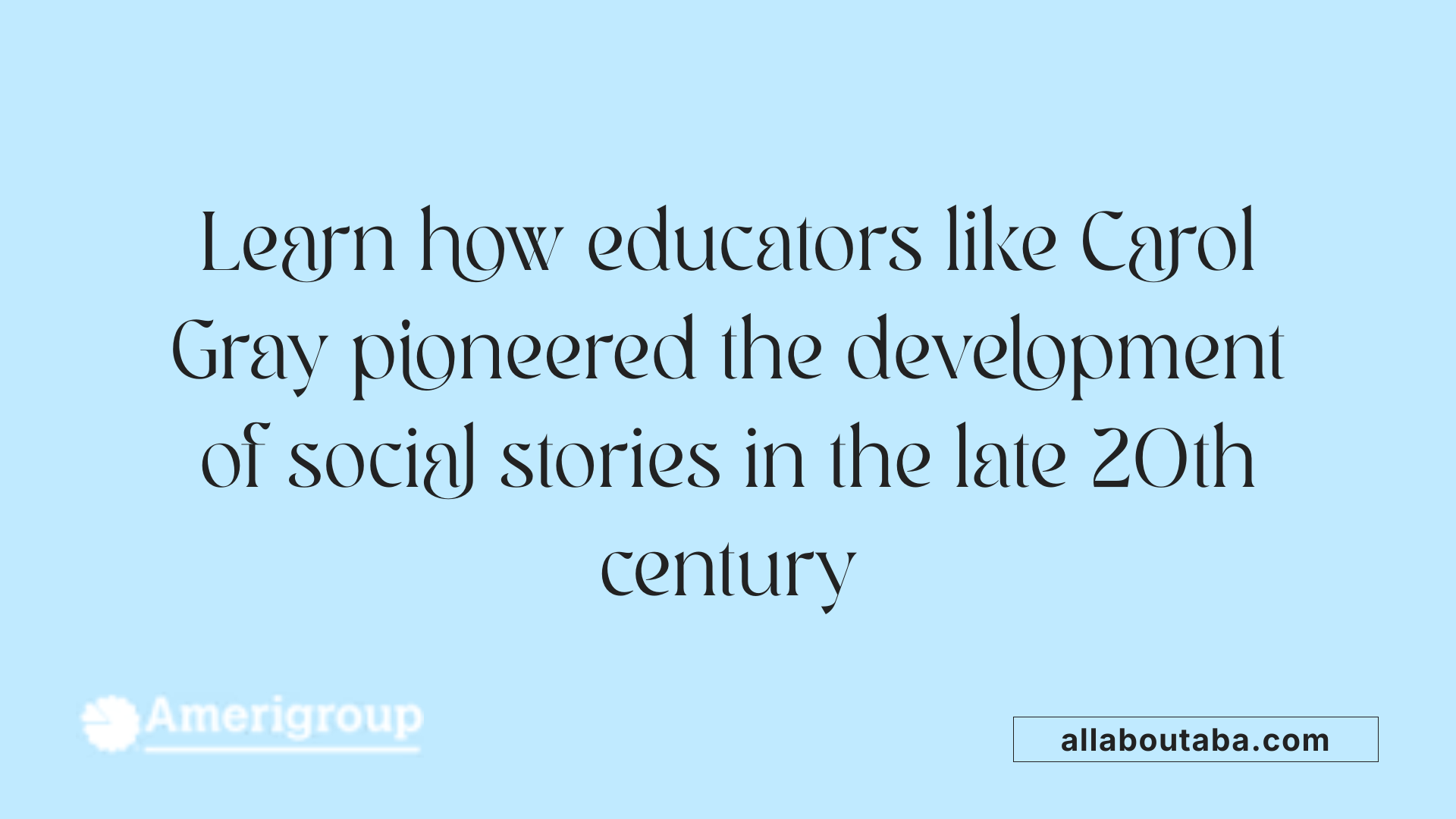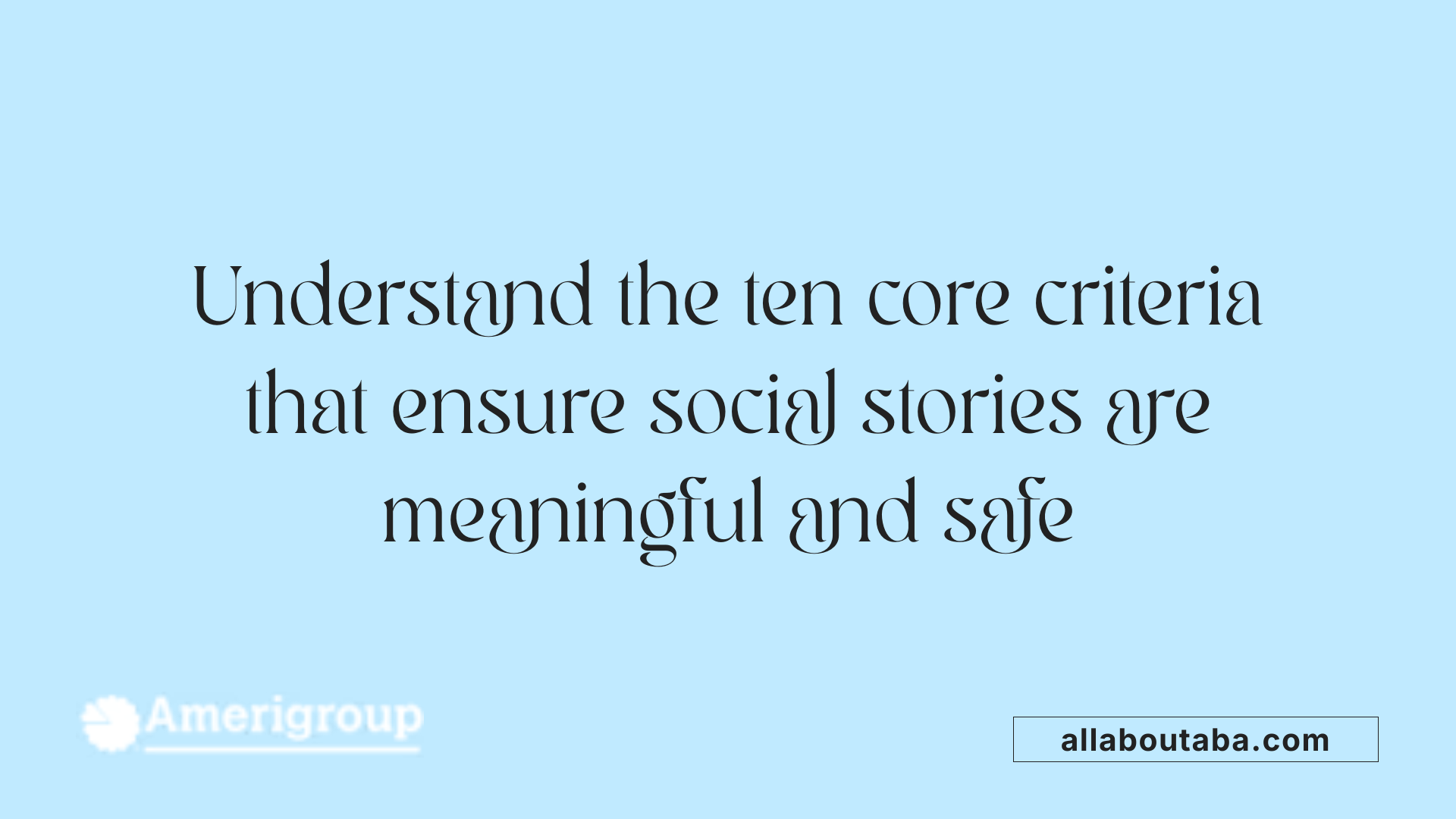Understanding Social Stories And How They Help Autistic Children
Understanding the Power of Social Stories in Autism Support
Social stories are a highly effective, evidence-based tool designed to help children with autism spectrum disorder (ASD) navigate complex social environments. Crafted as simple, personalized narratives, social stories provide clear guidance on social norms, expected behaviors, and appropriate responses, often utilizing visual cues to enhance understanding. Originating from the innovative work of Carol Gray in the early 1990s, these stories have become a cornerstone of social skill development, aiming to bolster self-regulation, empathy, and social competence in children with ASD.
Origins and Evolution of Social Stories

What is the background and origins of social stories?
The development of social stories traces back to the late 1980s, rooted in the efforts of educators and specialists aiming to improve social understanding among children with autism. The foundational work was conducted by Carol Gray, a teacher who began creating these stories around 1989-1990. Gray’s goal was to help children grasp social cues, norms, and expected behaviors through simple, personalized narratives.
Initially, these approaches were inspired by early educational strategies, including social packets devised at Jenison High School, which aimed to support students with autism in navigating real-world settings. These resources served as precursors to the more structured and formalized social stories.
The term 'social story' itself was first introduced by Carol Gray in 1991, marking a pivotal moment in autism intervention. Her method involves crafting brief, descriptive stories that adhere to ten specific criteria, ensuring they are meaningful, safe, and positive.
Over time, social stories have evolved into a widely recognized, evidence-informed intervention. They emphasize respecting each individual’s perspective, using clear and positive language, and often include visual supports. The approach has been refined through research and practice, integrating insights from early educational practices into a powerful tool for promoting social skills, reducing anxiety, and aiding behavioral change in children with autism.
Today, social stories are considered an essential resource in social skills training, often combined with other interventions such as speech therapy and behavior management, tailored to meet each child's unique needs.
Moreinfo Search Query: History of social stories in autism intervention
Researchers and practitioners continue to study and develop social stories, confirming their importance and adaptability across various developmental and mental health conditions.
Development, Structure, and Core Criteria of Social Stories

How are social stories developed and structured?
Creating effective social stories begins with a careful, individualized process. The development starts by collecting detailed information about the specific social situation and the child's needs, abilities, and interests. This involves a collaboration between professionals such as speech-language pathologists, psychologists, parents, and teachers to ensure the story accurately reflects the child's perspective.
Once the information is gathered, the social story is structured into several parts. It typically includes a clear title that introduces the topic, an introduction to set the context, the main body that describes the situation and appropriate behaviors, and a conclusion that reinforces expectations and provides reassurance.
To ensure relevance and effectiveness, social stories are tailored to the child's cognitive level and communication style. They often incorporate visual supports like pictures or symbols and use simple, positive language especially suited for children with language delays or non-verbal learners.
The stories must follow strict guidelines known as the ten criteria developed by Carol Gray. These criteria emphasize clarity, safety, and positivity. They serve as a blueprint for writing, revising, and delivering social stories so that children can understand and internalize the social information provided.
Overall, well-crafted social stories are personalized, structured tools that address specific social behaviors and emotional regulation challenges, helping children navigate complex social environments with confidence.
What are the essential features of well-crafted social stories?
Effective social stories share several important features that make them useful and engaging for children with autism spectrum disorder. First, the information included is accurate, literal, and meaningful, ensuring the child understands the social expectations.
Understanding the child's perspective is crucial, so stories are written with empathy and respect for their feelings and attitudes. This helps in making the content relatable and reassuring.
Structurally, a good social story follows a consistent format—starting with a title, followed by an introduction, the main description or behavioral instructions, and ending with a positive conclusion or reinforcement.
Positive language is emphasized throughout to foster motivation and reduce anxiety. The story answers essential questions like who, what, where, when, why, and how, providing comprehensive guidance.
In addition, social stories incorporate specific sentence types—descriptive, perspective, directive, control, affirmative, cooperative, and partial sentences—that serve different purposes. These sentences help clarify the situation, describe feelings and actions, and give gentle suggestions for appropriate responses.
Furthermore, praise and reinforcement are embedded to encourage the child and validate their efforts. Using these core features helps produce social stories that are not only informative but also safe, engaging, and capable of motivating behavioral change.
Best Practices for Implementation and Engagement
What are best practices for implementing social stories effectively?
Implementing social stories successfully involves several important steps. First, stories must be personalized to suit the child's specific social situation or skill gap. Writing from the child's perspective with positive, straightforward language ensures the stories are relatable and encouraging.
Visual supports such as pictures, symbols, or diagrams are crucial. They make the story more accessible and help children grasp abstract concepts more easily. Using templates or AI-based tools can also help ensure the stories follow a clear structure, including descriptive, directive, and positive sentences, making them age-appropriate and meaningful.
Re-reading the social stories regularly—both in structured therapy sessions and at home—reinforces learning and helps children internalize expected behaviors. The stories should be introduced during calm moments then referenced before or during relevant social situations.
Involving the child in creating the story—like choosing pictures or phrases—can increase buy-in and motivation. Practicing the story in real-life contexts with role-playing further enhances understanding.
Pairing social stories with explicit social skills instruction and reinforcement, such as praise or token systems, promotes positive behavioral changes. Doing so helps children generalize skills across different settings, which is vital for their social development.
Overall, consistency, personalization, visual supports, and active participation are essential for effective social story implementation.
Effects and Evidence Supporting Social Stories
What research evidence supports the effectiveness of social stories?
Numerous studies and systematic reviews support the positive impact of social stories on children’s social skills and behavior. The National Standards Project categorizes social stories as established methods to promote social understanding and reduce challenging behaviors in children with autism spectrum disorder (ASD).
Meta-analyses conducted by researchers like Kokina & Kern (2010) and Test et al. (2011) show consistent evidence that social stories can increase appropriate social interactions and decrease problematic behaviors. These studies utilized different designs, including single-case research, and found improvements in areas such as eye contact, greetings, and compliance.
Large datasets, such as those from the SOFA (Social Functioning and Autism) app, demonstrate that social stories are especially effective for younger, verbal autistic children and are adaptable through multimedia, video, and digital formats.
However, some reviews point out that overall scientific support remains limited and mixed. They emphasize the need for more rigorous research—especially randomized controlled trials (RCTs)—to better understand why and how social stories work and to identify the most effective formats and target populations.
What are the benefits and limitations of using social stories?
Benefits:
- Help children improve social communication skills and understand social cues.
- Reduce challenging behaviors such as tantrums, aggression, or frustration.
- Increase positive social interactions and peer engagement.
- Prepare children for transitions, unfamiliar situations, or upcoming events.
- Support emotional regulation and build self-esteem.
- Offer a low-cost, accessible intervention, especially when created by parents or professionals.
Limitations:
- Effectiveness may vary, especially among non-verbal children or those with complex needs.
- Most existing evidence relies on small studies or single-case reports, limiting generalizability.
- The current data highlight a need for more standardized research methods like RCTs.
- There may be variability in implementation quality, highlighting the importance of professional involvement.
Despite these limitations, social stories remain a popular, practical tool for tailored intervention in autism and related conditions.
| Aspect | Details | Additional Notes |
|---|---|---|
| Evidence Base | Supported by meta-analyses and systematic reviews | Mixed findings, more high-quality research needed |
| Effectiveness | Improve social interactions, reduce problem behaviors | Best when tailored and combined with other interventions |
| Format | Stories, multimedia, videos | Adaptable to individual needs and learning styles |
| Challenges | Variability in success, limited large-scale studies | Need for more RCTs and standardized protocols |
Ongoing research and future directions
Future research aims to establish stronger evidence through well-designed RCTs to clarify the specific factors that influence social story effectiveness. Researchers are also exploring digital tools, multimedia approaches, and interactive formats to enhance engagement and outcomes. As understanding grows, social stories are likely to become even more personalized and integrated into comprehensive intervention plans, maximizing their potential to support social and emotional development in children with ASD.
Resources and Tools for Parents and Professionals

Are there resources and examples of social stories available for parents and caregivers?
Yes, numerous resources and examples of social stories can be found to support parents and caregivers. Many online platforms provide free or printable social stories, which often include ready-made templates and suggestions to help develop personalized stories for a child's specific needs.
These resources typically guide caregivers on how to structure stories, using simple, positive language and visuals such as pictures or illustrations. They aim to clearly explain social situations, expectations, and appropriate responses in a way that children with autism can easily understand.
Professionals like psychologists, speech-language pathologists, and behavioral therapists often create these stories, but parents can access many parent-friendly materials as well. Many organizations and educational websites also offer comprehensive guides and collections of social stories, making it easier for families to implement them at home.
Using these resources, parents can adapt stories by including their child's name, interests, and specific situations, ensuring relevance and engagement. This customization helps reinforce learning and boosts the child's confidence in handling social interactions.
In summary, a wealth of accessible resources, templates, and examples are available, empowering parents and professionals alike to support social-emotional development through well-crafted social stories.
Empowering Social Growth in Children with ASD
Overall, social stories are a versatile, evidence-supported tool that empower children with autism to understand their social world better. When thoughtfully developed and properly implemented, they can significantly enhance social comprehension, reduce anxiety, and promote positive behaviors. As part of a holistic approach, involving professionals' guidance and parental involvement, social stories can transform social learning experiences, fostering confidence and independence in children with ASD. Continued research and resource development promise to refine and expand their utility, ensuring that every child can benefit from these personalized narratives.
References
- Social stories and autism | Raising Children Network
- Introduction - Social Stories™ to alleviate challenging behaviour ...
- Behavioral Issues and the Use of Social Stories: Articles
- Free library of Social Stories for Autism | Autism Behavior Services, Inc.
- What Are Social Stories for Kids With Autism?
- Using Social Stories to Improve Your Child's Understanding ...
- Effects of social stories intervention for children and adolescents ...
- Benefits of social stories for neurodiverse children - RWA Psychology
- Social Stories™ - National Autistic Society
Other articles
Recent articles

Cultural Perspectives On Autism Around The World

Autism And Creative Arts As Emotional Expression Tools

Developing Emotional Regulation Skills In Autistic Teens

Best Sensory-Friendly Lighting Solutions For Autism

Cognitive Behavioral Therapy Adaptations For Autism

Best Practices For Autism-Friendly Movie Screenings

Autism And Eating Challenges Beyond Picky Eating

Best Practices For Autism-Friendly Public Transport Design

Best Ways To Foster Collaboration Between Parents And Schools For Autism Support

Supporting Autistic Children During Transitions Between Activities

The Role Of Teachers In Fostering Autism Peer Acceptance

Using Art Therapy To Support Children With Autism

Autism And Strategies For Addressing Sensory Defensiveness

Autism And The Benefits Of Structured Leisure Activities

How To Support Autistic Students During Exam Season

Autism And Goal Setting For Personal Growth

How To Use Gamification In Autism Learning Programs

How Schools Can Reduce Bullying Of Autistic Students

Early Intervention Strategies For Autism Spectrum Disorder

The Role Of Therapists In Autism Life Skills Coaching

How To Support Autistic Individuals In Crisis Situations

Autism And Self-Care Routines For Stress Management

Understanding Echolalia And Its Role In Autism Communication

Autism And Fine Arts Education Benefits

The Impact Of Multisensory Learning On Autism Education

How Family Counseling Supports Autism Household Dynamics

Best Practices For Inclusive Playgrounds For Autism

Best Practices For Autism-Friendly Shopping Centers

How Autism Affects Fine Motor Skill Development

Best Ways To Introduce Sensory Activities Into Daily Routines

How Sports Teams Can Be Inclusive Of Autistic Players

Autism And Strategies For Building Workplace Resilience

Autism And The Impact Of Hormonal Changes During Puberty

How To Support Autistic Students In Foreign Language Classes

Best Ways To Teach Money Skills To Teens With Autism

Supporting Siblings Of Children With Autism

Autism And Co-Occurring Gastrointestinal Disorders

The Role Of Art Projects In Autism Sensory Integration

How Schools Can Incorporate Sensory Break Spaces

Best Practices For Autism Sensory Regulation At School

Autism And Strategies For Teaching Organizational Skills

Understanding The Relationship Between Autism And Anxiety Disorders

Autism And Life Planning For Long-Term Care

Exploring Visual Supports In Autism Education

Ways To Encourage Social Interaction In Children With Autism

The Connection Between Autism And Dyscalculia

The Role Of Occupational Therapy In Transition Planning For Autism

The Role Of Physical Therapists In Autism Motor Skills Support

How To Teach Decision-Making Skills To Autistic Young Adults

The Connection Between Autism And Epilepsy

Best Practices For Transitioning Autistic Children Into New Schools

Autism And Time Management Challenges In Adulthood

The Role Of Visual Arts In Autism Communication Development

How To Address Tactile Defensiveness In Autism

Best Practices For Telehealth Autism Therapy

How To Help Autistic Children Develop Friendship Skills

How Schools Can Support Autistic Students In Career Prep

Best Strategies For Autism-Friendly Event Planning

Understanding Noncontingent Reinforcement In Autism Behavior Plans

How Drama Therapy Benefits Autistic Individuals

Best Practices For Autism-Friendly Fitness And Recreation Centers

Best Ways To Promote Healthy Social Media Use For Autistic Teens

How To Help Autistic Children Cope With Public Speaking

Autism And Strategies For Managing Unexpected Changes

Best Podcasts About Autism For Parents And Educators

Autism And The Impact Of Seasonal Changes On Behavior

The Role Of Diet In Managing Co-Occurring Conditions With Autism

Sleep Challenges In Autism And Practical Solutions

Best Ways To Build Daily Routines For Autistic Children

Best Practices For Supporting Autistic Entrepreneurs

Autism And Strategies For Navigating Large Social Gatherings

Adaptive Sports And Recreational Activities For People With Autism

Autism And The Benefits Of Story-Based Learning Activities

Understanding The Role Of Play In Autism Development

Autism And The Impact Of Environmental Noise On Learning

How To Create Autism-Friendly Community Spaces

Autism And Chronic Health Conditions: What To Know

The Role Of Care Managers In Autism Life Planning

How To Teach Social Boundaries To Autistic Children

How Autistic Individuals Experience Empathy Differently

How To Support Autistic Employees In Remote Work Settings

Autism And The Relationship Between Motor Skills And Learning

How To Create Community Resource Guides For Autism Families

How To Teach Daily Living Skills To Autistic Teens

Autism And The Impact Of Mind-Body Practices On Stress Reduction

Autism And The Benefits Of Outdoor Group Activities

How To Create Autism-Friendly Sensory Paths In Schools

Best Practices For Autism-Friendly Park And Recreation Areas

Autism And Strategies For Reducing School Refusal

Supporting Autistic Individuals In Public Speaking

The Role Of Diet In Managing Autism Symptoms

The Benefits Of Gardening Clubs For Autism Social Development

How To Prepare Autistic Children For Dental Visits

Autism And Employment: Career Paths That Work

Best Practices For Autism-Friendly Hotels And Lodging

The Impact Of Screen Time On Autism Development

Autism Screening Tools For Early Childhood

The Role Of Physical Exercise In Autism Therapy

Best Strategies For Supporting Autistic College Students

The Role Of Technology In Autism Early Detection
We’re All About You, Your Family, and Your Child

